September 2023: Character Woodcarving: Jim Hiser and Aron Rook
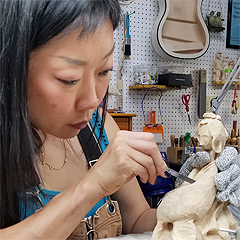
In our Spotlight series, we take a closer look into the kaleidoscope of traditional arts in Central Pennsylvania and the work of artists featured in our Folk Artists Gallery. In this article, we check in with the third of our 2023 traditional arts apprenticeships.
By SFMS folklorist Amy Skillman
In the summer of 2023, I had the opportunity to visit the woodcarving studio of Jim and Joan Hiser of Carlisle, PA to observe an apprenticeship lesson with Aron Rook. Jim is a nationally-renowned carver of expressive character figures, and Aron is expanding her considerable artistic skills into the three-dimensional medium of woodcarving.
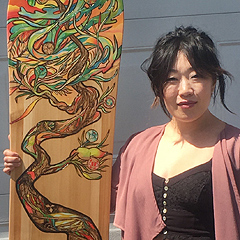 Read Aron Rook's profile in our Folk Artists Gallery to learn more about this multi-talented young muralist, illustrator and creator.
Read Aron Rook's profile in our Folk Artists Gallery to learn more about this multi-talented young muralist, illustrator and creator.
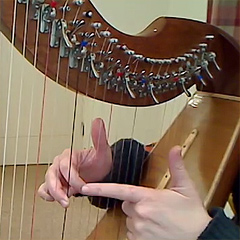 Read our Spotlight article on Virtual Apprenticeships to see how our other two apprentices from this grant cycle made distance learning work.
Read our Spotlight article on Virtual Apprenticeships to see how our other two apprentices from this grant cycle made distance learning work.
Apprenticeships are intended to pass on the artistic skills, the history, and the cultural knowledge that makes the art so meaningful to the practitioners.
As a Folk Arts Partner with the Pennsylvania Council on the Arts (PCA), one of SFMS’s roles is to support local artists in applying to the PCA's Apprenticeships in Traditional Arts grant program. Last year we helped three artists with their applications and all three were funded: not a bad track record. Two partnerships connected local apprentices with distant masters via Zoom. Aron's partnership with Jim is a more conventional face-to-face apprenticeship: a master/mentor artist guiding the work of a student, sustaining a tradition and ensuring its future.
Making connections
Aron Rook is an accomplished local artist with strong skills in several visual arts areas. Although her arts focus as a child was dance and music, then illustration as a young adult, she also fondly remembers growing up with the smell, sights, and sounds of her grandfather's wood-carving hobby. Increasingly aware of how much he influenced her artistic journey, she regrets not learning more from him before he passed away.
After inheriting her Grandfather Rook's wood-burning machine, and beginning to create with it, Aron discovered a powerful sense of family connection and even deeper cultural connections.
Exploring those connections was part of the impetus for her apprenticeship. As a trans-national adoptee from Korea, raised within a central Pennsylvania family, Aron has been interested in the concept of lineage: both her Korean lineage and her Pennsylvania lineage.
Aron noticed a similarity between the expressive faces of Jim's carved figurines and the stylized masks of the Korean folk theater known as Talchum.
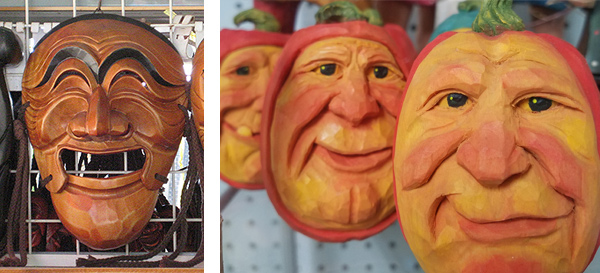
Talchum masks are hand carved, each one a unique representation of the emotion being expressed by the performer. No one in the local Korean community knows this art form. But as a caricature carver, Jim captures these exaggerated expressions in wood. Aron's artistic goal is to carve those evocative faces herself.
 Aron says that realizing she is now part of Jim’s carving lineage was a revelation. He talks a lot about the mentors who guided and encouraged him, and she recognizes those generations of knowledge being passed on to her.
Aron says that realizing she is now part of Jim’s carving lineage was a revelation. He talks a lot about the mentors who guided and encouraged him, and she recognizes those generations of knowledge being passed on to her.
A day in the studio
The Hisers' wood-carving studio is in the back half of a neatly-converted two-car garage at the end of a long driveway. The house and studio sit on many acres of rolling green lawn with a view of the State Game Lands and Blue Mountain to the north. I arrived a little after 1:00 pm and was greeted by Jim’s wife Joan, also a wood carver. She had been working in the yard, perhaps tending the vibrant flowers surrounding the house. It was a sunny day with the kind of blue sky that makes all the colors pop.
I met Jim in the studio where he was setting up for the day. Two well-loved wooden tables are pushed together in the middle of the room, creating enough space for several students to sit and carve. The walls are lined with cabinets, tools, tool chests, photographs, posters, and display cases of carved characters in various stages of completion. As we waited for Aron to arrive, Jim pointed out pieces he had collected, pieces he had carved, and pieces in process.
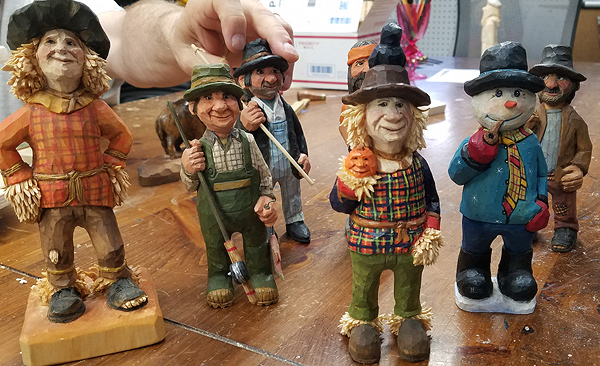
Some carvers start with drawings, but Jim prefers clay models because they are malleable and 3-dimensional, like the final carving. Once satisfied with the clay model, he begins carving, using the model as a reference point. Basswood is his preferred wood.
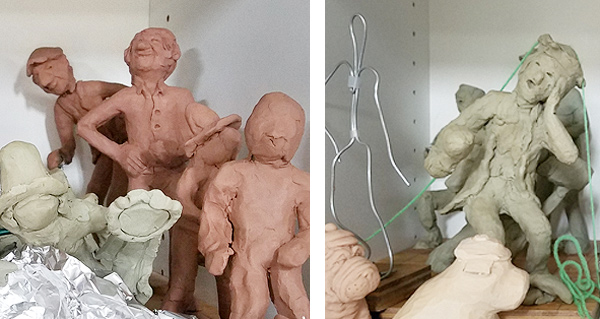
For his one-of-a-kind pieces, he carves until he is happy with the character. Joan, who often carves at the other end of the table, said she sometimes hears him giggle as something especially delightful emerges in the character. She also noted that if he doesn’t like the face, she tells him to change the music he is listening to. Joan often does the painting on the pieces Jim has carved, unless he is entering it into a show, in which case he has to do the painting.
For pieces Jim plans to use in his carving classes, he creates a “rough-out.” This is a carving with a basic shape, and no details. He sends this to one of two woodworkers with a machine that “maps” the shape and creates replicas. The replicas become the starting point for his beginner carving classes. The students add the details.
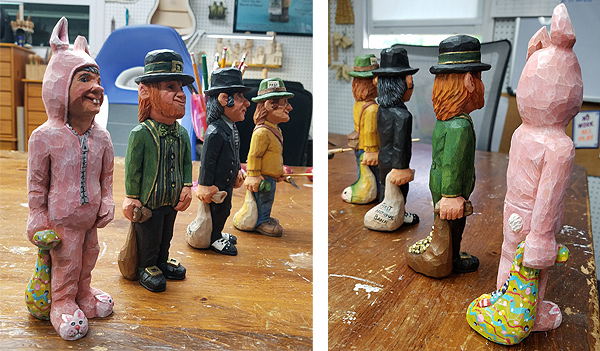
Family ties
When Aron arrived, she was excited to show Jim a carved buffalo gifted to her by a friend — it was carved and signed by her Grandfather Rook! Realizing the connection, the friend knew Aron had to have it. Aron asked Jim if they could do a carving of a buffalo next. As it turns out, Jim used to carve animals before he got into character carving, so they agreed that would be next.
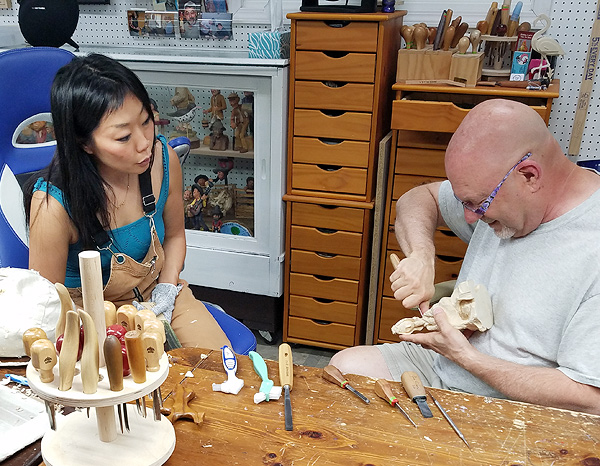
What the faces say
Both caricature carving and Talchum theater have their roots in satire. In one interpretation, the masks of the Talchum characters offered the freedom to anonymously criticize and make fun of powerful local people, such as members of the aristocracy or the Buddhist monastic hierarchy. Some of the plays also mock stereotyped versions of annoying personalities within the lower classes: the drunkard, the gossip, the flirt, or the constantly-complaining grandmother. These characters can show up in American caricature drawings and carvings as well.
Not all Talchum is satirical, just as not all caricature carvings foster stereotypes. These expressive artistic traditions entertain, heal, lift our spirits, and remind us of our humanity.
There are twelve primary characters in the Talchum pantheon, including the young bride, an old woman, the fool, and the Buddhist monk or shaman. To learn and practice her new skills, Aron carved faces/masks for three of the characters, each about the size of a goose’s egg. Notice the similarity between these masks' exaggerated facial expressions and the expressions on Jim's figures.
Beside her three practice masks is Aron’s carving of a heart: a talisman for staying true to herself.
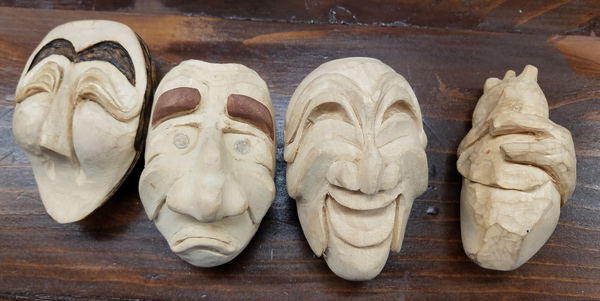
Getting to work
Aron unpacked her tools and the piece she is currently working on: a figure of the Talchum character "the young bride." Having started with modeling, as Jim does, she is now bringing it to life in wood. Once Aron got settled into working on her carving, we talked about the apprenticeship.
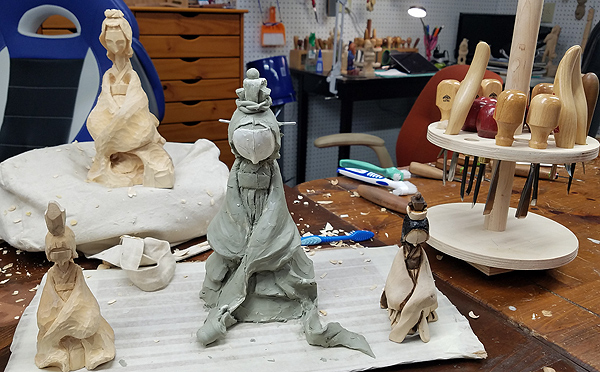
Jim says Aron has been an easy apprentice because of her art background. He often sends her home with a piece to work on and is amazed by what comes back — she definitely puts her own spin on the piece. “She runs with it,” he says.
Their first several sessions focused on the basic mechanics of carving, with Aron practicing techniques on small spiral carvings, a few owls, and the masks mentioned above. As they got better acquainted, they adjusted the original apprenticeship workplan to better fit Aron’s skills and needs.
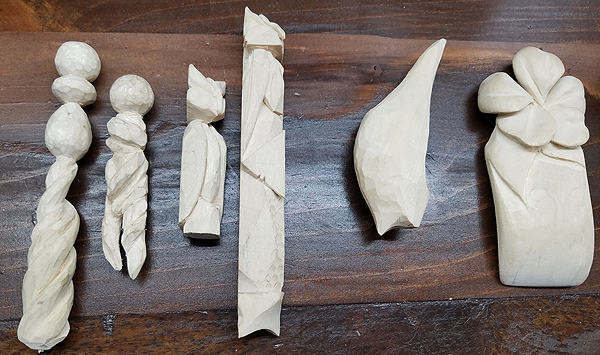
Joan stayed in the studio for most of the session. She even brought us drinks and her homemade coconut-lime zucchini bread. There is clearly affection between Aron and this carving couple. The three of them share an easy rapport. In fact, Jim has invited Aron to continue to come to his studio after the end of the official grant, and they are talking about applying for a second grant next year.
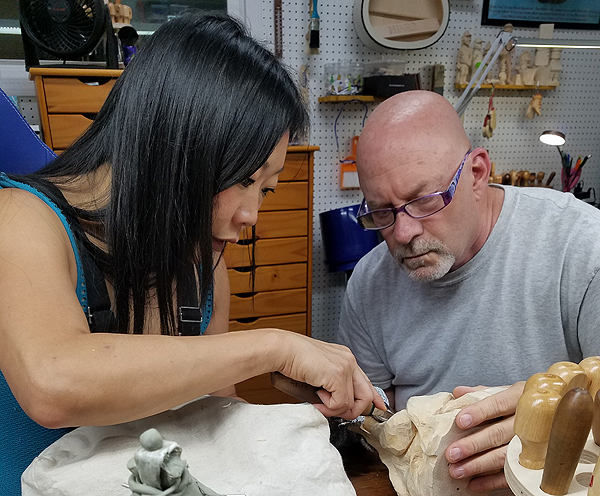
As Aron worked, Jim’s guidance was gentle and encouraging. Once in a while, she asked him to show her how to fix a section, or clear an area of “chibbles” (small shavings that don’t come away). But mostly, he watched her work. He gave her a specific task to “add more flow” to the sleeve of the bride’s clothing, offering various tools to achieve different details.
Aron says she is putting all her trust in Jim to guide her and to assess her work. She trusts that he will tell her when something is not good and, when he compliments her work, she believes him. She is clearly an eager student, curious, competent, and open to learning.
Picking it up, passing it on
Many years ago, Jim signed up for a carving class at the Mechanicsburg Art Center. He was a furniture maker at the time, and wanted to add some decorative carved elements to his furniture. He became so enthralled with carving animals that he never went back to furniture making.
Jim initially resisted when one of his mentors encouraged him to try caricature carving. In the professional or competitive carving world, it isn’t valued — like many “folk art” traditions.
The enjoyment of creating delightful characters won out, though. Jim is now a nationally-sought-after artist and teacher, and a member of the Caricature Carvers of America, an elite group of carvers recognized by their peers for their excellence. Perhaps all it will take is an art collector to start paying attention, to elevate Jim's style of carving to an art form.
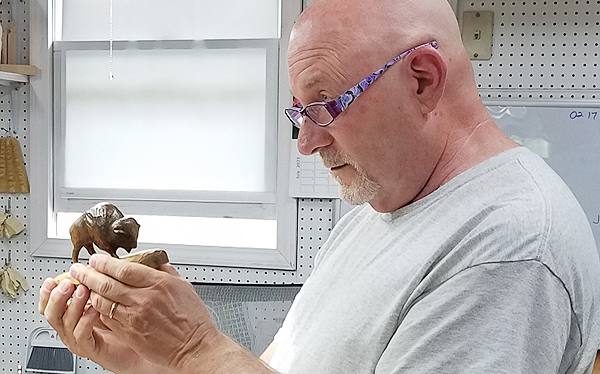
On the other hand, Jim observes that — unlike other forms of carving — caricature carvers are willing and eager to share their secrets with those who want to become part of that lineage and carry it forward.
“Passing on the skills and techniques is the only way the art will survive.” —Jim Hiser
I left the studio with a small bag of zucchini bread in my hand and a belief that this partnership will have lasting benefits for everyone involved.


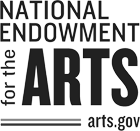
Brand icons for Facebook, YouTube, Instagram and other social media platforms are the trademark of their respective owners. No endorsement is implied.